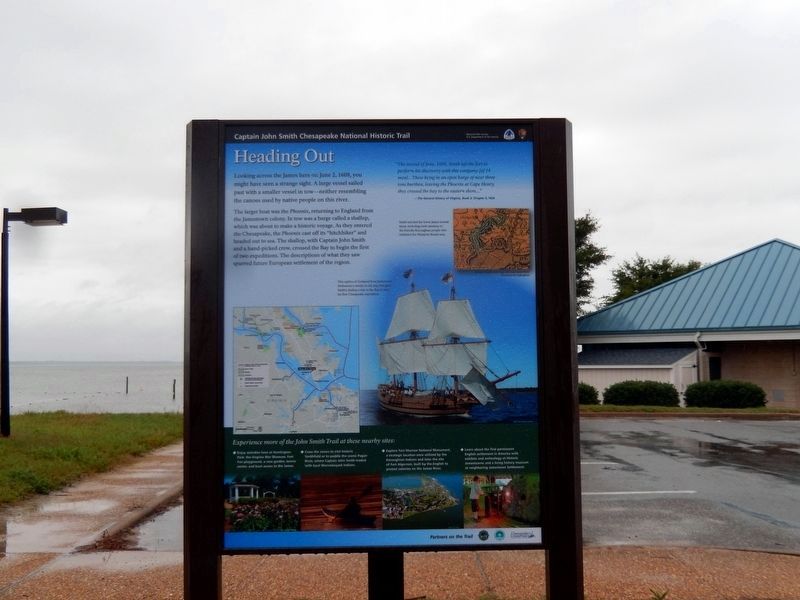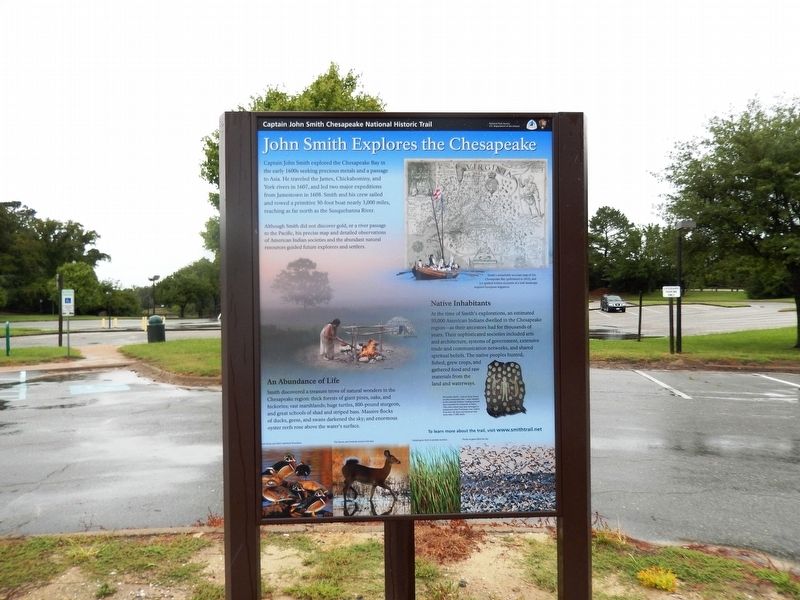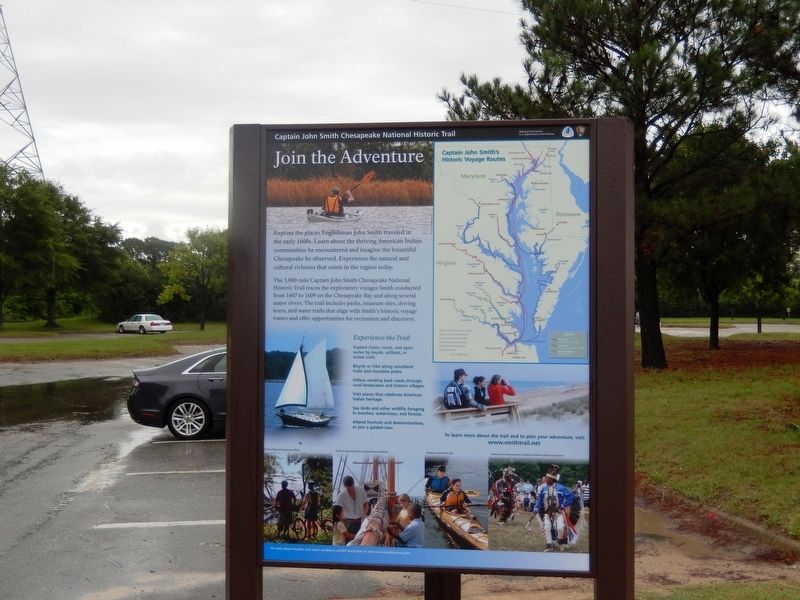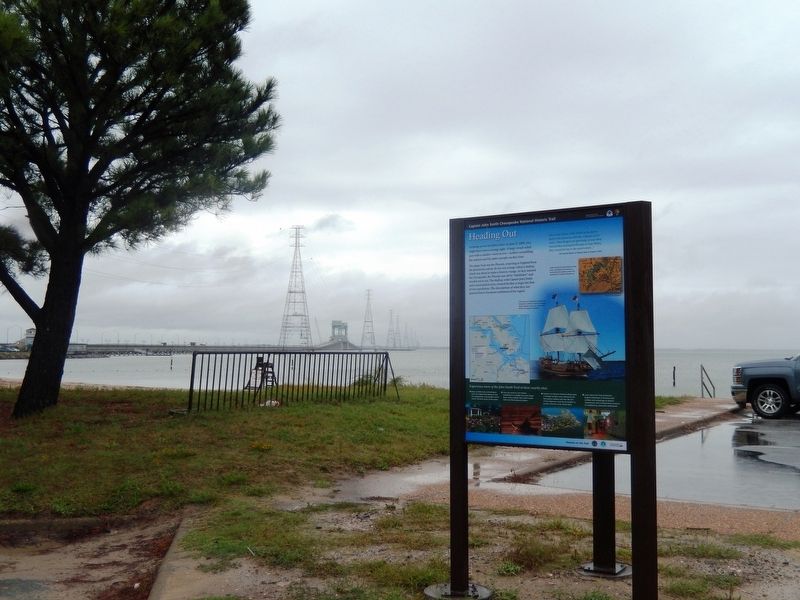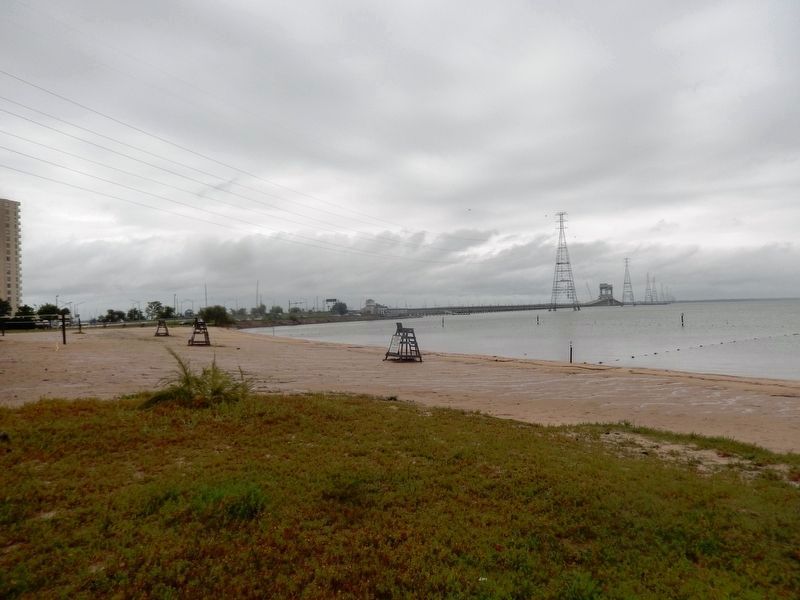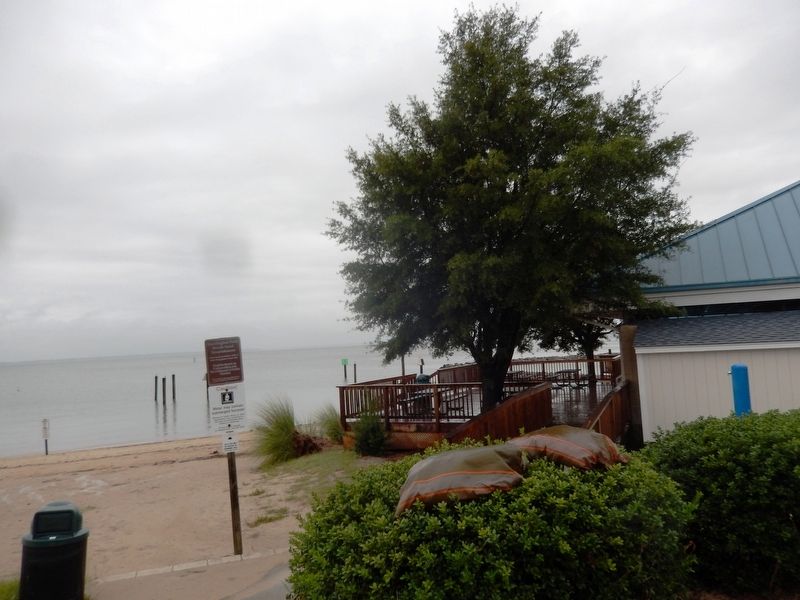South Newport News , Virginia — The American South (Mid-Atlantic)
Heading Out
Captain John Smith Chesapeake National Historic Trail
— National Park Service, U.S. Department of the Interior —
(panel 1)
Looking across the James here on June 2, 1608, you might have seen a strange sight. A large vessel sailed past with a smaller vessel in tow—neither resembling the canoes used by native people on this river.
The larger boat was the Phoenix, returning to England from the Jamestown colony. In tow was a barge called a shallop, which was about to make a historic voyage. As they entered the Chesapeake, the Phoenix cast off its “hitchhiker” and headed out to sea. The shallop, with Captain John Smith and a hand-picked crew, crossed the Bay to begin the first of two expeditions. The descriptions of what they saw spurred future European settlement of the region.
“The second of June, 1608, Smith left the fort to perform his discovery with this company (of 14 men)… These being in an open barge of near three tons burthen, leaving the Phoenix at Cape Henry, they crossed the bay to the eastern shore…”
-The General History of Virginia, Book 3, Chapter 5, 1624
(captions)
(lower center) This replica of Godspeed from Jamestown Settlement is similar to the ship that gave Smith’s shallop a ride to the Bay to start his first Chesapeake expedition.
(upper right) Smith traveled the lower James several times, including trade missions to the friendly Kecoughtan people who inhabited the Hampton Roads area.
(sidebar)
Experience more of the John Smith Trail at these nearby sites:
• Enjoy activities here at Huntington Park: the Virginia War Museum, Fort Fun playground, a rose garden, tennis center, and boat access to the James.
• Cross the James to visit historic Smithfield or to paddle the scenic Pagan River, where Captain John Smith traded with local Warraskoyack Indians.
• Explore Fort Monroe National Monument, a strategic location once utilized by the Kecoughtan Indians and later the site of Fort Algernon, built by the English to protect colonies on the James River.
• Learn about the first permanent English settlement in America with exhibits and archeology at Historic Jamestowne and a living history museum at neighboring Jamestown Settlement.
(panel 2)
John Smith Explores the Chesapeake
Captain John Smith explored the Chesapeake Bay in the early 1600s seeking precious metals and a passage to Asia. He traveled the James, Chickahominy, and York rivers in 1607, and led two major expeditions from Jamestown in 1608. Smith and his crew sailed and rowed a primitive 30-foot boat nearly 3,000 miles, reaching as far north as the Susquehanna River.
Although Smith did not discover gold, or a river to
the Pacific, his precise map and detailed observations of American Indian societies and the abundant natural resources guided future explorers and settlers.
Native Inhabitants
At the time of Smith's explorations, an estimated 50,000 American Indians dwelled in the Chesapeake region—as their ancestors had for thousands of years. Their sophisticated societies included arts and architecture, systems of government, extensive trade and communication networks, and shared spiritual beliefs. The native people hunted, fished, grew crops, and gathered food and raw materials from the land and waterways.
An Abundance of Life
Smith discovered a treasure trove of natural wonders in the Chesapeake region: thick forests of giant pines, oaks, and hickories; vast marshlands, huge turtles, 800-pound sturgeon, and great schools of shad and striped bass. Massive flocks of ducks, geese, and swans darkened the sky; and enormous oyster reefs rose above the water's surface.
To learn more about the trail visit www.smithtrail.net
(captions)
Smith’s remarkably accurate map of the Chesapeake Bay (published in 1612), and his spirited written accounts of a lush landscape inspired European migration.
Decorative shells-such as those found on this ceremonial robe-were valuable in the American Indian’s trading network that extended for hundreds of miles. This robe (which may have belonged to paramount chief Powhatan) was crafted from four elk skins and adorned with more than 17,000 shells.
Wood ducks and other waterfowl flourished
The forests and lowlands teemed with deer
Cattails grew thick in pristine marshes
Flocks of geese filled the sky
(panel 3)
Join the Adventure
Explore the places Englishman John Smith traveled in the early 1600s. Learn about the thriving American Indian communities he encountered and imagine the bountiful Chesapeake he observed. Experience the natural and cultural richness that exists in the region today.
The 3,000-mile Captain John Smith Chesapeake National Historic Trail traces the exploratory voyages Smith conducted from 1607 to 1609 on the Chesapeake Bay and along several major rivers. The trail includes parks, museum sites, driving tours, and water trails that align with Smith's historic voyage routes and offer opportunities for recreation and discovery.
Experience the Trail
• Explore rivers, coves, and open water by kayak, sailboat, or motor craft.
• Bicycle or hike along woodland trails and shoreline paths.
• Follow winding back roads through rural landscapes and historic villages.
• Visit places that celebrate American Indian heritage.
• See birds and other wildlife foraging in marshes, waterways, and forests.
• Attend festivals and demonstrations, or join a guided tour.
To learn more about the trail and to plan your adventure, visit
www.smithtrail.net
(captions)
Captain John Smith’s Historic Voyage Routes
“Here are mountains, hils, plaines, valleys, rivers, and brookes all running most pleasantly into a faire Bay compassed but for the mouth with fruitful and delightsome land.”
– John Smith, 1612
Overlooking the Susquehanna River
Students aboard Discovery at Jamestown Settlement
Kayakers explore the trail
Indian dance demonstration at Jefferson Patterson Park and Monument
Erected by National Park Service, U.S. Department of the Interior.
Topics and series. This historical marker is listed in these topic lists: Colonial Era • Exploration • Native Americans • Settlements & Settlers. In addition, it is included in the Captain John Smith Chesapeake National Historic Trail series list. A significant historical date for this entry is June 2, 1608.
Location. 37° 0.996′ N, 76° 27.337′ W. Marker is in Newport News, Virginia. It is in South Newport News. Marker can be reached from Riverpark Road north of Mercury Boulevard (U.S. 258), on the left when traveling north. The marker is located in Huntington Park near the beach. Touch for map. Marker is in this post office area: Newport News VA 23607, United States of America. Touch for directions.
Other nearby markers. At least 8 other markers are within walking distance of this marker. Lake Biggins (about 300 feet away, measured in a direct line); Ferguson Park (approx. 0.2 miles away); 21 cm Mörser (approx. 0.2 miles away); Virginia War Museum (approx. ¼ mile away); Pearl Harbor Survivors (approx. ¼ mile away); 40mm/56 Quad Mount Bofors Anti-Aircraft Gun (approx. ¼ mile away); M53 Self Propelled Gun (approx. ¼ mile away); Vietnam War Monument (approx. ¼ mile away). Touch for a list and map of all markers in Newport News.
Credits. This page was last revised on February 1, 2023. It was originally submitted on October 3, 2016, by Don Morfe of Baltimore, Maryland. This page has been viewed 422 times since then and 21 times this year. Photos: 1, 2, 3, 4, 5, 6. submitted on October 3, 2016, by Don Morfe of Baltimore, Maryland. • Bernard Fisher was the editor who published this page.
